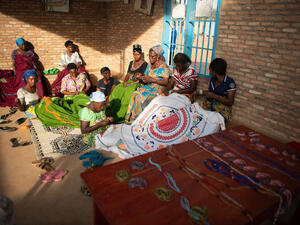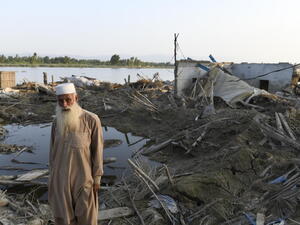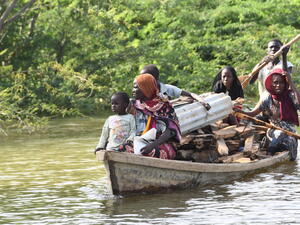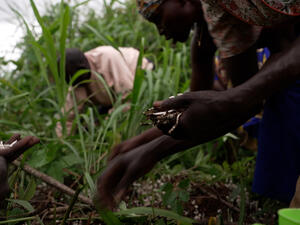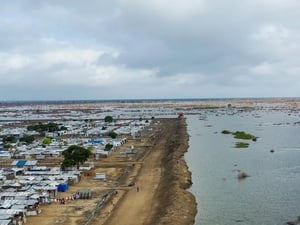Six months on, flood-displaced Pakistanis return home to reconstruct
Six months on, flood-displaced Pakistanis return home to reconstruct

Jan Muhammad in the compound of his home, which he is helping to rebuild. The family have been living in the UNHCR tent.
KATBAR MOHALLA, Pakistan, January 26 (UNHCR) - Six months after devastating floods first hit Pakistan in July 2010, some 166,000 people are still displaced and living in more than 240 camps and spontaneous settlements.
This is substantially down from the peak levels last September and October, when 3.27 million people were living in camps, but it still represents a substantial population in need of help. UNHCR has been providing assistance to many of them, but it is also helping a large number of those who have gone back to their villages and started rebuilding their damaged or destroyed homes.
Jan Muhammad fled from his home in southern Pakistan's Balochistan province when the swirling waters swept through his village, Katbar Mohalla, last August. The village lies in Jaffarabad, which was the worst affected district in the province with more than 16,000 houses in 851 villages destroyed.
Sixteen-year-old Muhammad and his family returned to the village last November to find a sea of muddy water and bricks. Their belongings had either been washed away or buried beneath the rubble.
"The entire neighbourhood was levelled," Muhammad told recent UNHCR visitors to the village. "The water was above my knees," added the teenager, who was making bricks for a wall to surround the family's rebuilt two-room home.
Next he will install roofing material, doors and windows donated by UNHCR under a shelter programme for people whose homes were damaged or destroyed by the flooding. The agency has pledged to build 16,000 temporary shelters in Balochistan with the help of local implementing partners. Work has either begun or been completed on 75 per cent of them.
Towns and villages in eastern Balochistan are gradually showing signs of renewal after being under water for weeks. Shops and markets have reopened and people have started rebuilding homes in Katbar Mohalla and hundreds of other villages in the worst-hit districts of Jaffarabad and Naseerabad.
When the floodwaters hit Katbar Mohalla in August, the village was home to some 400 families, or about 3,000 people. They all fled, but today almost 90 percent are back and have started reconstruction work.
"Only a few lucky ones found their homes undamaged," noted Muhammad's ailing father, Ghulam. "We pumped out some of the water so that we had a little bit of space on which to put up our tent," he added. But stagnant water is a problem, while some areas remain marshy.
There are other challenges for the returnees. A small number are struggling to reclaim their lands, while others have lost documentation needed for such things as receiving aid, proving land ownership and school enrolment. Some have lost their livelihoods because of the floods.
"I don't have a single penny. I've no source of income and I am waiting for help," said Rashida, a widow and mother of five whose badly damaged house in Katbar Mohalla is in danger of collapse. As part of its shelter programme, UNCR is funding the construction of 500 one-room shelters in Balochistan for those deemed to be particularly vulnerable, including Rashida.
Meanwhile, some 25,000 people are still living in 39 camps in Balochistan, which was first hit by flooding on July 22 last year. A further 128,000 are spread across 188 locations in Sindh province, while more than 13,000 are in 16 camps in Khyber Pakhtunkhwa province in the north. Many of these people lack the means to rebuild their homes, while others have lost livelihoods and are without sufficient cash or transport to move on.
Over the past six months, UNHCR has provided emergency shelter to almost 2 million people as part of the joint humanitarian effort. The refugee agency remains committed to helping 665,000 people across Pakistan with shelters. UNHCR has also been providing warm clothes, blankets and plastic sheeting to people living inside and outside of camps to survive the winter weather.
By Duniya Aslam Khan in Katbar Mohalla, Pakistan



